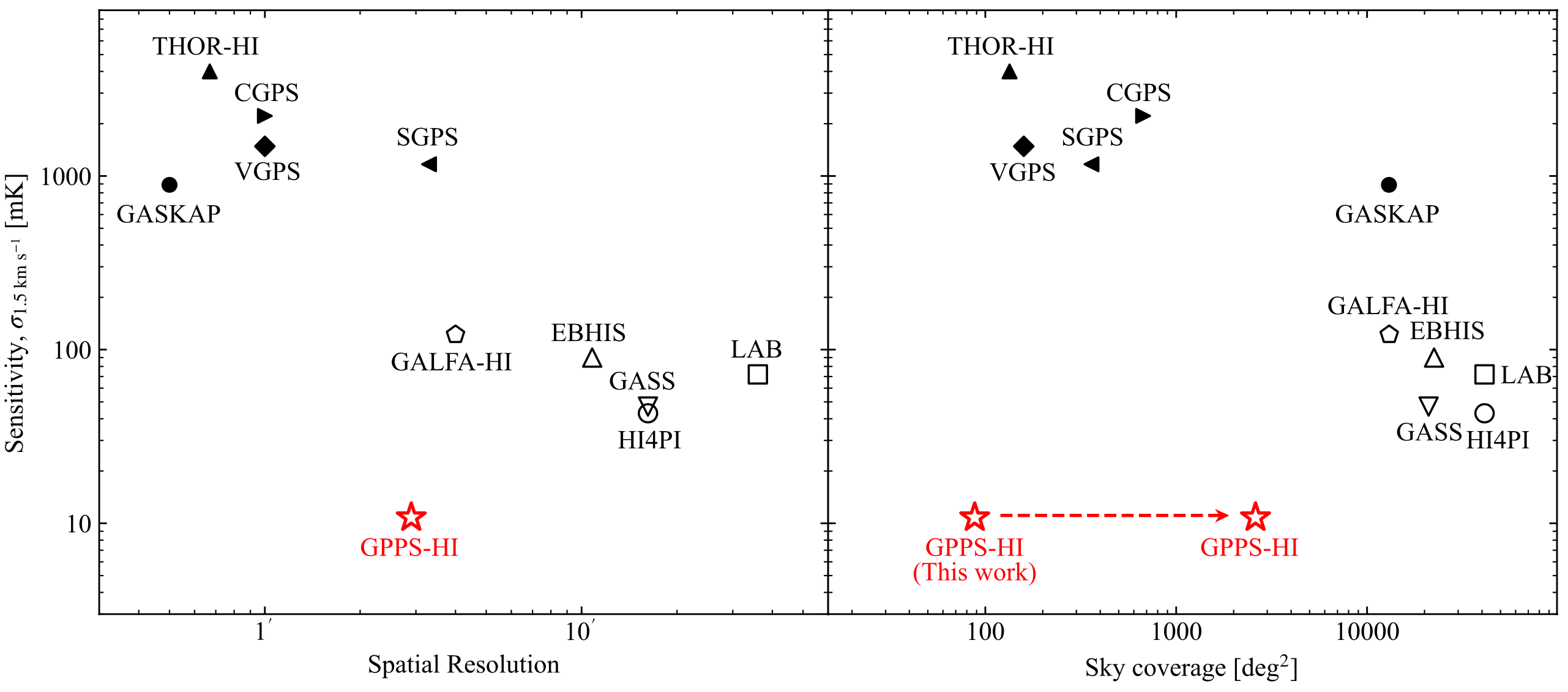Peering Milky Way by FAST.HI
Peering the Milky Way by FAST:
Neutral Hydrogen Gas (HI)
detected in the GPPS piggyback spectral data
Neutral hydrogen (HI) is one of the fundamental components
of the Galactic interstellar medium. The HI gas is the raw material
for star formation and plays an important role in galaxy
evolution. Observing the emission line of the Galactic HI gas can
reveal the structure and dynamics of the Galaxy over a much extended
region in the Galactic disk even in the very far side of the
Galaxy. Both single dish radio telescopes and interferometers have
been used to observe the Galactic HI gas.

Fig.1: Comparison of the normalized flux sensitivity at the same
spectral resolution of 1.5 km/s for the famous Galactic HI surveys
versus the survey spatial resolution (left) and the sky coverage
(right). The interferometric surveys are labeled with the filled
symbols and the single-dish surveys by open symbols.
During observations of the
Galactic Plane Pulsar Snapshot (GPPS) survey, a set of independent
spectrum digital backends are connected to the 19-beam L-band
receivers, and the four polarization products of spectral line
data of 1024k channels covering the frequency band of 1000
- 1500 MHz are simultaneously recorded. The huge collecting area
of FAST and the 5-minute long integration time for each beam make
the GPPS piggyback spectral data the most sensitive survey of
Galactic HI emission/absorption by far (Fig.1).
We have processed the piggyback HI data for the region of the Galactic longitude from 33 to
55 degree and the Galactic latitude within ± 2 degree (Fig.2). The
initial released HI data product has a velocity resolution of
0.1 km/s in the range of -300 km/s to +300 km/s. It can
be used to detect exquisite interstellar HI structures and
improve our understanding of the interstellar medium.

Fig.2: The HI column density map integrated over the velocity
range of -150 km/s to +150 km/s.
The FAST GPPS survey piggyback HI data product:
(v1.0 in a fits file) is released here.
Since data in some observations have much more RFIs, we will be continuously improving the data processing for the piggyback spectra of the FAST GPPS survey, e.g. on baseline fitting, RFIs cleaning etc, and will update the data product and release new version of the fits file.
You are welcome to use this most updated version of fits file.
If you find any problem or have any comments and suggestions, please contact us.
Publication
Tao Hong*, Jinlin Han*, Ligang Hou, Xuyang Gao, Chen Wang, and Tao Wang, 2022,
Peering into the Milky Way by FAST: I. Exquisite HI structures in the inner Galactic disk from the piggyback line observations of the FAST GPPS
survey, SCPMA, Vol.65, No.12, 129702
See News and View by Prof. John Dickey
Contact: hongtao@nao.cas.cn, hjl@bao.ac.cn

